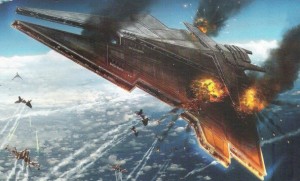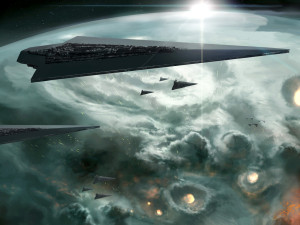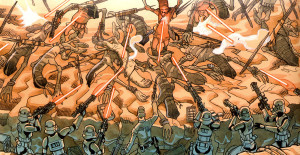
Alas, despite the name, this is not to be an exhibition of the countless fine works that have been produced by this franchise’s artists over the years, though they would undoubtedly be deserving of such a feature. Instead, today we’ll be taking some time to discuss the place of military strategy in Star Wars – or rather, the technological basis that makes it all possible.
As even a cursory study of history will tell you, the methods by which wars are fought have always depended heavily on the tools available at the time. All great advances in weaponry have heralded significant changes in the very nature of how warfare is conducted – consider the evolution in our own history from mounted knight in armor to modern infantryman, or from ancient galley to aircraft carrier.
Despite their somewhat eclectic nature, the standards of warfare in the universe of Star Wars are fairly well established, if not the specifics. Starfighters are more or less analogous to World War II fighter aircraft, infantrymen are still deeply entrenched in trench warfare, and starships map more closely to the great vessels of the Age of Sail than actual spacecraft, lining up alongside each other and blasting away with broadsides.
It is an approach that I, for one, wholeheartedly endorse: while a realistic depiction of space combat might be scientifically interesting, it would make for rather dull watching and reading. However, in a galaxy that often finds itself sundered by war, even such dynamic portrayals of combat will eventually become stale, so it would be of considerable benefit to us to be forward-thinking about what we can do to stir the formula a bit to keep it fresh.

I have previously advocated treating worlds more as countries than towns – now, I will ask you to imagine them as fortresses, for they possess the significant strategic advantage of being (in most cases) self-sustaining. The Death Star was a revolutionary weapon capable of annihilating entire worlds and would have forever altered the military landscape of the galaxy had it been permitted to continue existing, but its example also teaches us something very important: that the power to destroy a planet is not insignificant next to the power of the Force – at least from a military perspective.
Given the firepower possessed by titanic Star Destroyers, it’s not unreasonable to think that (at the very least) most important and wealthy planets might have some means of defending themselves against anything less than an Imperial technological terror: a guess validated by the Expanded Universe.
If we take a planet as being self-sustaining and potentially immune to (easy) orbital bombardment, then that presents an intriguing possibility: siege warfare, on a planetary scale. The situation of the besieged is obviously a tense one, ripe for drama, particularly if communications with the rest of the galaxy have been cut off, as they were with Naboo. That is not to say that the besiegers are resting easy, however. Besieging a planet that may never run out of supplies is a lengthy proposition, and one that could tie up a significant number of forces if you don’t want to run the risk of having the siege broken by a relief force.
If compelled to force the planet into a more immediate submission, then you’re faced with the prospect of bringing down the shields by means of overwhelming force, subterfuge, or a ground invasion, depending on the nature of the barrier and its limitations. And, once that is accomplished, one might have to deal with fortifications of a more terrestrial nature, guarded by smaller shields similar to what protected the rebel base on Hoth, leaving no choice but to send in the infantry.

To return again to the example of Naboo, simply bringing down the shields and capturing the vital regions of the world you wish to conquer is really only the first step. The planet must then be garrisoned and brought to heel, lest it simply rise up against you as soon as the fleet departs. Simply bombing them into obedience tends not to be a viable long-term strategy, and is bad manners besides. As such, you then have the possibilities of resistance movements and insurrections on your hands, and collaborators and double agents as well.
A planet covers a great deal of ground, and that leaves a countless places for enemies of the occupiers to hide and organize themselves. Can you imagine trying to track down a group of rebels that could literally be hiding anywhere on Earth? You could easily spend months or years searching, even with an army of probe droids at your disposal. Furthermore, stories such as these are viable in nearly any era, but never need be the same twice, as each planet brings with it a different set of circumstances to take into account.

Now, let’s talk about sticks and stones. More specifically, as wielded by homicidal ambulatory teddy bears. When somebody utters the words “asymmetric warfare” in our usual context, the Battle of Endor is probably what comes to mind. Fair enough. It’s a clear example, if an improbable one. But it’s not the only example, or even the most interesting. Take, for instance, the Battle of Maridun from To the Last Man. As filtered through the movie Zulu, it’s based on the very real Battle of Rorke’s Drift, in which several thousand Zulu warriors (armed mostly with shields and spears) assaulted and were repelled by a hundred and fifty British soldiers and their rifles.
And in a galaxy such as that of Star Wars, this is only one of an extraordinarily broad range of possible scenarios, given the radical differences in environments between planets and even the technology used by different species. Based on what we know, it’s entirely possible that a military campaign might have to heavily adjust its strategy for every individual world it encountered based on its landscape and inhabitants. Now imagine that as told from a soldier’s perspective: a constant stream of new enemies and terrain, and new tactics that must be invented and adjusted to in order to succeed.

Even all of this is only the tip of the iceberg when it comes to the types of stories just waiting to be told about the more arcane aspects of galactic warfare. We’ve seen the glory of the heroes of starfighter duels, but there are also bombers and reconnaissance pilots who should not be forgotten, to say nothing of aerial duels fought within a planet’s atmosphere and the struggle to gain control of the airspace over cities. Naval and submarine warfare are known to exist, but completely ignored in all but a very small handful of cases (the Battle of Mon Cala in The Clone Wars being one of the most interesting and memorable parts of the entire series). Psychological and electronic warfare might not make for exciting adventures, but they can round out a supporting cast and provide context for risky missions for those acting to further their goals.
Given the nature of the rebellion against the Empire, insurgency and propaganda are closely entwined fields, and could make for even more compelling tales than one might normally expect. How often does one see rebel rabblerousers and firebrands in action (or the Imperial counter-insurgency specialists opposed to them) after all, attempting to incite entire populations to rise up against the Empire and working behind the scenes to pull the necessary strings to ensure an entire world’s freedom? Far too often we come too early or too late to the cause, when a world is firmly under Imperial control or just on the verge of being liberated: there exists a wealth of possible stories that could be told about the struggle between those two extremes.
It stands to reason that we’re going to see a great many battles in the near and far future, on the big screen and on paper, before, during, and after the Galactic Civil War. There are new stories to tell and old ones to retell. Those battles that we are treated to could be seen as something akin to the highlights reel of the history of war in the galaxy far, far away, and I think it would be worth our effort if we attempted to make them as diverse and interesting on an individual basis as possible. To give each battle its own character, so that no two are ever quite the same, even if both were fought on desert or ice worlds against the same enemy. It’s a lesson that the franchise’s video games have learned quite well over the years, but also one that the films, comics, and novels alike should keep in mind as we advance into a new era of galactic warfare.
